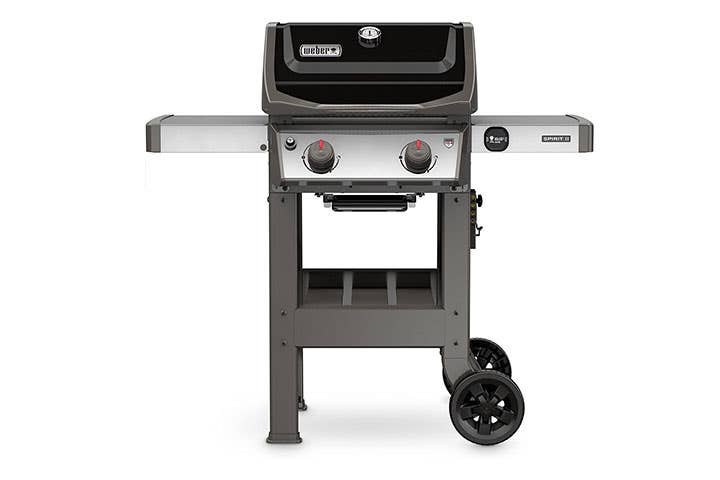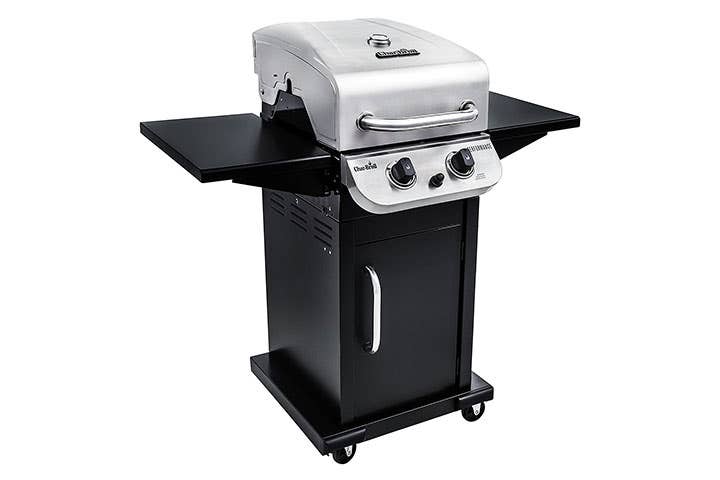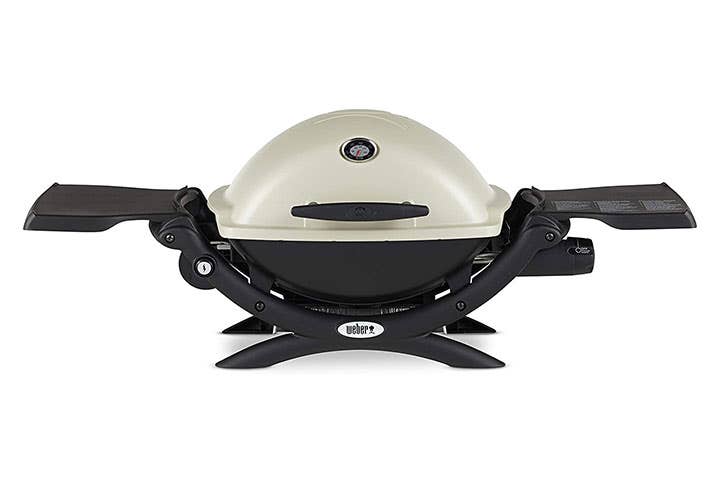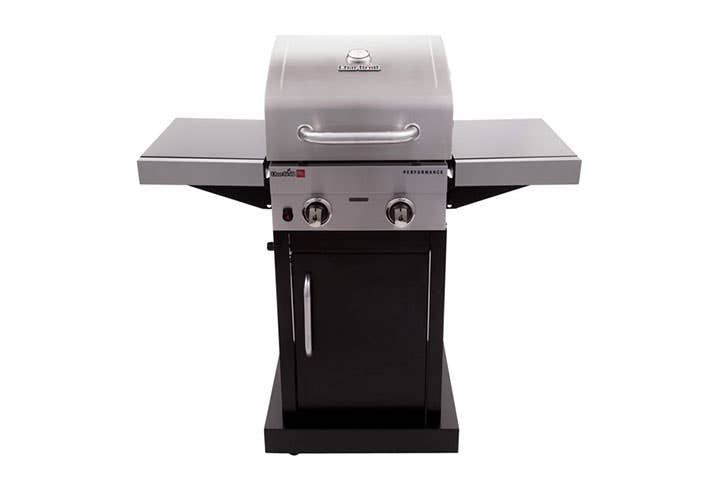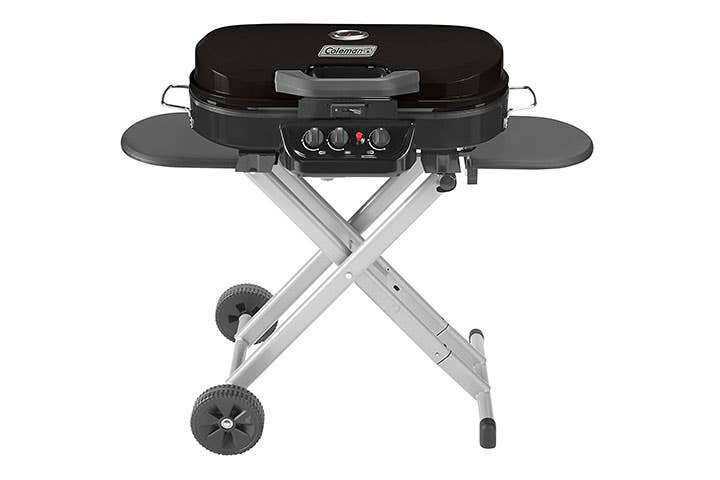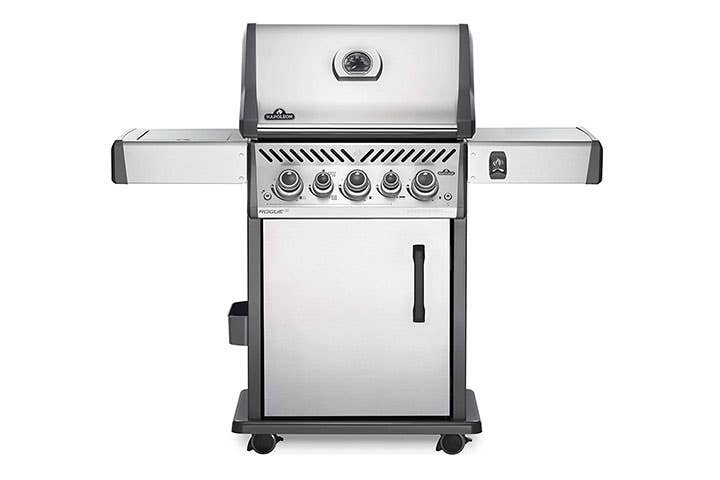The Best Small Gas Grills for Decks, Patios, and Beyond
You’ll be flipping burgers all summer, even if your outdoor living space is short on space.
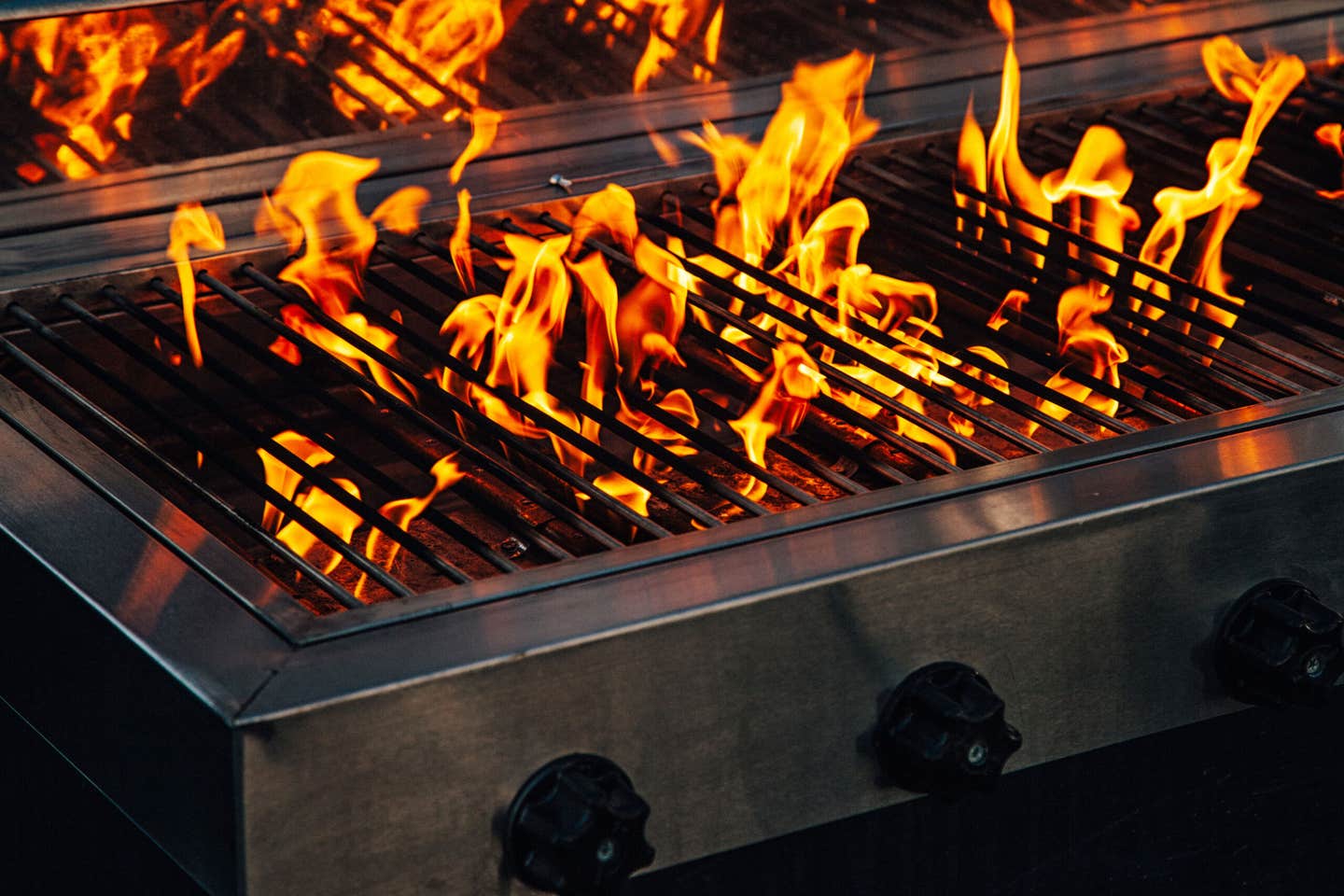
By and large, the most convenient way to barbecue outdoors is with a gas grill. They light at the push of a button and are easier to clean than charcoal, making them ideal for backyard decks and patios. However, full-sized gas grills can stretch over five feet long, taking up valuable real estate on small decks and patios. Luckily, those with limited outdoor living space do not have to forego outdoor cooking. There's a wide selection of small gas grills with foldable side tables that measure less than 3 feet wide and even come equipped with wheels that make them easy to maneuver into a corner or even an adjacent storage room when not in use.
Some small gas grills are compact and lightweight enough to take on the road for tailgating events and camping trips, too. If you’re looking to add a gas grill that fits a smaller deck or patio to your repertoire, here are some of the best small gas grills for your summer of outdoor cooking endeavors.
The Best Gas Grills: Our Top Picks
- Best Overall: Weber Spirit II E-210 Gas Grill
- Best Value: Char-Broil Performance Series 2-Burner Propane Gas Grill
- Best Portable: Weber Q1200 Gas Grill
- Best Infrared: Char-Broil Performance TRU-Infrared 2-Burner Gas Grill
- Best for Camping: Coleman Roadtrip 285
- Best Natural Gas: Rogue SE 425 Natural Gas Grill
Best Overall: Weber Spirit II E-210 Gas Grill
Best Overall
Primary Cooking Area: 360 square inches | BTUs: 26,500 | Material: cast iron | Item Dimensions: 48 inches wide by 57 inches high by 26 inches deep | Item Weight: 103 pounds
Pros
- Durable heavy-gauge steel construction
- Smart thermometer capable
- Reputable Weber name
Cons
- Expensive
- Only two burners
- Visible propane tank
Why we chose it: Weber’s gas grills are highly regarded for their heat output and durability.
Weber’s grills are known for their excellent build quality, and the Spirit II is no exception. It's constructed of much heavier gauge steel and a tighter build than you’ll find on lower-priced gas grills. Its burners easily get hot enough to achieve the sought-after Maillard reaction, so you’ll have no trouble achieving that brown crust that makes steaks and burgers so when cooked on the grill.
While Weber offers many gas grills, the Spirit II is the most compact at just four feet wide with the side tables fully extended. And though It may be small, it still has more than 350 inches of cooking surface, plenty of room for a dozen good-sized burger patties or six New York strip steaks. The Spirit II also comes with additional features that make it cooking on it a breeze, including an infinity ignition and a smart thermometer system that allows you to monitor meat temperatures with your smartphone (if you purchase a compatible meat thermometer).
Best Value
Main Cooking Area: 288 square inches | BTU Output: 24,000 BTUs | Material: Stainless steel | Item Dimensions: 43 inches wide, 24.5 inches deep, and 44 inches high | Item Weight: 83 pounds
Pros
- Affordably priced
- Narrow profile suits tight spaces
- High heat output
Cons
- Not as durably built as pricier grills
- Smaller cooking surface than other gas grills
- Limited storage space
Why we chose it: With this stainless steel construction and high heat output, the Performance is the best of the budget-priced gas grills we reviewed.
Most of the time you get what you pay for when it comes to grills, but that’s not the case with the Char-Broil, which has made a name for itself by manufacturing quality gas grills at a budget price through its Performance line. This 2-burner model is the line’s most compact model, measuring under 32 inches wide with the side tables folded down. That narrow profile coupled with casters that allow you to roll it into a corner when not in use makes it a great option for those with limited space on their patio or deck. And, with its stainless steel construction and a cabinet-style base that conceals the propane tank, it won’t detract from the aesthetics of your outdoor living space. Of course, looks and size would mean little if the grill didn’t perform. The Performance lives up to its name with two burners that pump out 24,000 BTUs, more than enough to heat up its 288 square inches of cooking surface.
Best Portable: Weber Q1200 Gas Grill
Best Portable
Cooking Area: 189 square inches | Total BTUs: 8,500 | Material: Cast iron and aluminum | Item Dimensions: 41 inches wide by 16.5 inches deep by 15.5 inches high | Item Weight: 31 pounds
Pros
- Affordably priced
- Narrow profile suits tight spaces
- High heat output
Cons
- Not as durably built as pricier grills
- Smaller cooking surface than other gas grills
- Limited storage space
Why we chose it: The Q1200’s compact size and smart design make it the best all-around portable gas grill.
Weber’s Q1200 is easy to use, compact, and solidly built, making it the perfect companion for a trip to the beach, campground, or stadium parking lot. It’s easy to start with an electric ignition and heats up in about 10 to 15 minutes using a one-pound propane fuel canister. Dual porcelain-coated cast iron plates that are easy to clean post barbecuing. At 31 pounds and measuring just a few feet wide, you won’t struggle to get the Q1200 into the trunk of your car. And, even though it’s small, it still boasts 189 square inches of cooking surface, enough for half a dozen burgers or a few steaks. We also love the fold-out side tables that create valuable prep space you don’t usually get with a portable grill and the cast iron clamshell lid with an integrated thermometer.
Best Infrared: Char-Broil Performance TRU-Infrared 2-Burner Gas Grill
Best Infrared
Primary Cooking Area: 310 square inches | Total BTUs 18,000 BTUs | Material: Aluminum and stainless steel | Item Dimensions: 41 inches wide, 16.5 inches deep and 15.5 inches high | Item Weight: 96 pounds
Pros
- Easily reaches sear level temperatures
- Stainless steel construction
- Enclosed cabinet conceals tank
Cons
- Porcelain grates are difficult to clean
- Not as durable as pricer grills
- Smaller cooking surface area
Why we chose it: This grill can easily reach seer temperatures and features all stainless steel construction.
The main criticism of many small gas grills is that they lack the ability to achieve that 550 degrees-plus temperature that really ensures a good sear on steaks and crispy edges on burgers. This model from Char-Broil uses infrared heat, allowing it to reach surface temperatures that exceed 600 degrees, plenty of heat for searing.
We also like the compact size of this two-burner grill. With the side tables folded down, it measures just a hair over 27 inches wide, so it won’t crowd small patios and decks, but still has more than 310 square inches of primary cooking surface. And if aesthetics are important to you, you’ll like its stainless steel lid, control panel, and side tables.
Best for Camping: Coleman Roadtrip 285
Best for Camping
Cooking Area: 285 square inches | Total BTUs: 20,000 | Material: Aluminum and cast iron | Item Dimensions: 32 inches long, 18.5 inches deep and 15.5 inches high | Item Weight: 47 pounds
Pros
- Three cooking zones
- Folds up and rolls for transport
- Ample cooking surface for a portable grill
Cons
- Needs two people to lift it into the trunk and set it up
- Takes up more space in the trunk
- Expensive for a portable gas grills
Why we chose it: We couldn’t find a portable grill with more cooking space and as many cooking zones as the Roadtrip 285.
Coleman is one of the best-known names in RVing and camping products, so it should come as little surprise that its aptly named Road Trip is an ideal grill for cooking in the great outdoors. The main appeal is in its portability and well-designed cooking surface. And while at 50 pounds this grill isn't light, it folds flat and has two large wheels that allow you to roll it behind you like a piece of luggage.
The cooking surface features three gas burners, which is almost unheard of on a portable grill. With those three cooking zones, you can sear a steak, roast kabobs, and grill vegetables all at the same time with ample space for all, since it has 285 square inches of cooking surface. We also love the cast iron non-stick grill plates, which make post barbecue clean-up easy.
Best Natural Gas: Rogue SE 425 Natural Gas Grill
Best Natural Gas
Cooking Area: 425 square inches | Total BTUs: 70,500 BTUs | Material: Stainless Steel | Item Dimensions: 48.5 inches wide by 25 inches deep by 55 inches high| Item Weight: 146 pounds
Pros
- Separate Infrared sear burner
- High total BTU Output
- Broad cooking surface
Cons
- Expensive
- Side shelves don’t fold down
Why we chose it: The Rogue manages to remain compact while still boasting three cooking zones, separate sear burners, and 425 square inches of cooking surface.
What sets the Napoleon apart from other grills is its use of two types of burners. In addition to its four standard propane burners, the rogue features two infrared burners at the rear, allowing you to achieve a sear on steaks or even use the grill as a rotisserie. Couple that with its four front standard burners and you’ve got a grill that can create a lot of different cooking zones. There’s also an infrared side burner to boot, useful for heating sides or warming sauces. Even with its 425 square inches of cooking space, the Rogue manages to remain at a fairly narrow width of 48 inches, though the side tables do not fold down. We also like its all stainless steel construction, which includes the cooking grates, giving it a richer look for your outdoor living area.
How We Chose The Best Small Gas Grills
I used my experience testing dozens of grills to make our selection of the best small gas grills. We limited our selections to more compact grills that measure four feet or less long with preference given to those with folding side tables that offered even more space savings. I selected established brands that are known for their performance and durability. Additionally, BTUs are crucial for properly searing with a grill, so I chose those with ample BTU output for the size of their grilling surfaces. When possible, I selected grills that offer ample cooking space and multiple cooking zones for their size.
Features to Keep in Mind When Shopping for Small Gas Grills
Cooking/Working Space
Small gas grills that max out at around four feet wide with their side tables up aren’t going to offer the same broad swath of cooking space as full-sized models. Expect to get between 350 and 450 square inches of cooking surface for a small gas grill compared to the 600 plus inches of cooking surface you’d get with a full-size model. Portable gas grills typically have around 200 square inches of cooking surface. About 400 to 500 square inches of cooking surface is suitable for a family of four; if you’re entertaining with a small gas grill, you’ll likely have to cook in waves to grill enough food to feed everyone.
Fuel Type
There are two types of gas grills: natural gas and propane gas. The latter requires a 20-pound propane tank, which connects to the grill via a regulator. You’ll find 20-pound propane tanks at most grocery stores, home improvement stores, and gas stations. Since it’s notoriously difficult to gauge how much gas is left in a propane tank, it’s a good idea to have spare to avoid running out mid backyard barbecue. A natural gas grill ties directly to your home’s gas line, ensuring you have a constant supply of fuel and eliminating the need to lug a 50-pound tank around. But, unless you already have one, you’ll have to pay to run a gas line to your patio or deck, which can be expensive. Keep in mind that gas grills are made to operate with either propane or natural gas, not both. You cannot hook a propane gas grill to a natural gas line or vice versa without using a conversion kit.
Portability
Tailgating, camping, and beach trips are all fun opportunities to grill away from home. And for that, you’ll need a good portable gas grill. Portable grills are of course much lighter than their full-sized cousins, with most weighing around 20 to 30 pounds with a compact shape that makes them easy to fit into the trunk of a car. Some larger portable models may even come equipped with wheels, allowing you to roll them from car to campsite or wherever your remote cooking location may be.
Gas Grill Cooking Power and BTUs
A grill’s ability to heat the cooking surface to hot enough temperatures that make it possible to sear or provide even heat is directly related to the BTUs of its burners. For the uninitiated, BTUs stands for British Thermal Units, which is a measure of heat output. A quality gas grill’s burners will produce between 70 and 90 BTUs per square inch. So, a grill with 400 square inches of cooking surface should put out between 28,000 and 36,000 BTUs to evenly heat the cooking surface. Searing involves creating intense focused heat over a targeted area on the grill surface of at least 500 degrees (the higher the better). Some gas grills have a separate sear station, which consists of a single burner or cluster of burners that produce a higher BTU output and hence higher surface temperature than the other burners on the grill.
Number Of Burners In Your Grill
The number of burners on a gas grill determines the number of cooking zones you can create. A cooking zone is the number of different heat levels you can create on your grill’s cooking surface simultaneously. Most small gas grills come equipped with two burners, which means you’ll be able to create two cooking zones that allow you to cook at two different temperatures simultaneously, which is ideal if you're grilling different types of food.
Ask the Experts
Q: How do I set up a small gas grill?
Most small gas grills require some assembly after they arrive. Once it's been assembled, find a flat, level location on your deck or patio away from flammable items like mulch or nearby hedges, out of the path of foot traffic. A gas grill has a threaded regulator that screws onto the grill’s gas valve. Make sure the regulator is securely attached before opening the tank’s valve. Gas grills light via a push-button piezo ignition or an electric ignition that requires a AAA battery. Always light the grill with the hood open to prevent a build up of gas that can cause an explosion.
Q: What type of gas should I use with a gas grill?
If you’re using a propane gas grill, you’ll need to use a 20-gallon propane natural gas tank. Most portable gas grills use a one-pound gas canister. A natural gas grill will attach directly to your home’s gas line. Remember, you can only use a natural gas grill with natural gas and a propane gas grill with propane gas.
Q: Are gas grills better than charcoal grills?
Whether a gas grill is better than a charcoal grill or vice versa is a matter of personal preference. Many people like the ease of use that a gas grill offers. Others are willing to deal with a labor-intensive lighting process and messier clean-up in order to get the smokey flavor and extreme temperatures you can only achieve with a charcoal grill.
Q: Can I hook up natural gas to my propane grill?
You can hook up a natural gas grill to a propane grill, but you’ll need to purchase a conversion kit to do so. Since natural gas burns cooler than propane, natural gas grill burners have larger holes to allow the grill to reach high enough temperatures for grilling. This design difference means that it’s dangerous to hook up a propane tank to a natural gas grill.
Q: How do I avoid flare-ups on a gas grill?
There are a few strategies you can employ to prevent flare-ups that can burn food and singe the hair off your forearms. Flare-ups are usually the result of meat juices dripping onto the burners, so trim excess fat off meat before placing it on the grill. Clean your grill regularly as built-up grease and char are the main causes of flare-ups. You can also leave one burner off while grilling, creating a safe zone for your food when flare-ups occur—no one likes a sad, smoke-blackened hot dog.
Q: Why won't my gas grill get hot enough?
The most common reason why your grill is no longer getting hot is the regulator, which has a built-in safety that reduces the flow of gas if it senses a gas leak. These safety devices often trigger even when there is no leak in the line, preventing your grill from reaching temperatures over 300 degrees. Reset the regulator by disconnecting it, opening all the valves on the grill, closing them, then reconnecting the line.
Q: How do I replace a gas grill igniter?
To replace the gas grill igniter, begin by unscrewing the ignition button of the starter. Replace the battery and see if that fixes the problem. If it doesn’t, you’ll need to replace the entire igniter. Begin by unscrewing the ignition button and pulling the starter out of the control panel. Snap a photo of the wiring with your smartphone to record its placement, then disconnect them from the old igniter. Insert the new igniter, which you ordered from the manufacturer, and install the wires into the same holes. Reattach the igniter to the control panel and insert a fresh battery.
Final Take
It’s hard to underestimate the importance of brand and BTU output when choosing a small gas grill. While the Weber Spirit II E-210 Gas Grill may be one of the pricier options on the market, it boasts a 26,500 BTU output and comes from a brand known for the durability of its products. In short, the Spirit II will sear food more easily and last longer than grills than more cheaply priced grills. Those on a budget should consider the Char-Broil Performance Series 2-Burner Propane Gas Grill, which comes from a manufacturer that also has a reputation for building quality grills at an affordable price.
Keep Reading
Continue to Next Story
